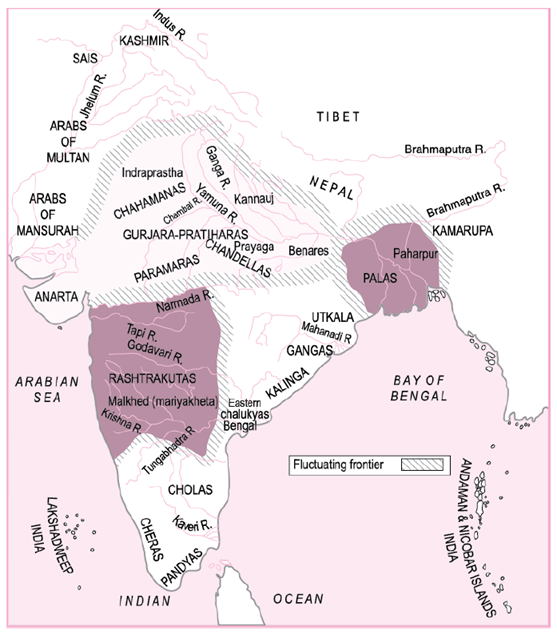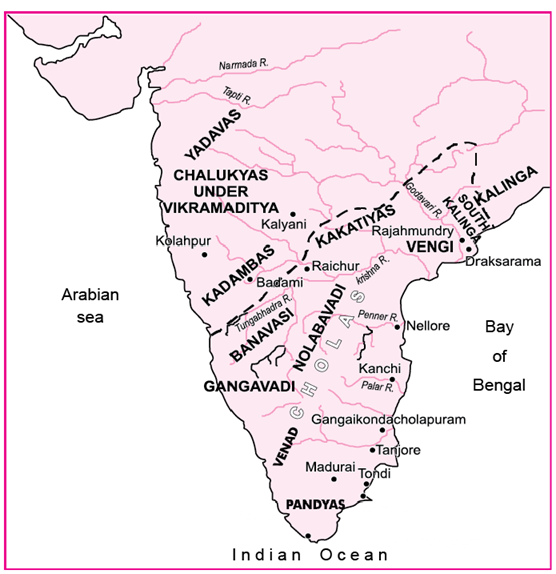NCERT Solutions for Class 7 History Chapter 2 New Kings And Kingdoms
NCERT Solutions for Class 7 Social Science History Chapter 2 New Kings and Kingdoms contains the answers to the exercises given in the NCERT History book. These solutions are easy and accurate that help you to answer the questions asked in the examinations. NCERT Solutions for Class 7 History Chapter 2 are prepared by our subject experts in very easy language. Practice these solutions regularly to ensure excellent marks in the exams.
NCERT Solutions for Class 7 Social Science History Chapter 2
Question 1: Match the following:
| Gurjara-Pratiharas | Western Deccan |
| Rashtrakutas | Bengal |
| Palas | Gujarat and Rajasthan |
| Cholas | Tamil Nadu |
Answer:
| Gurjara-Pratiharas | Gujarat and Rajasthan |
| Rashtrakutas | Western Deccan |
| Palas | Bengal |
| Cholas | Tamil Nadu |
Question 2: Who were the parties involved in the “tripartite struggle”?
Answer: The parties involved in the “tripartite struggle” were the Gurjara-Pratiharas, Rashtrakutas and Palas.
Question 3: What were the qualifications necessary to become a member of a committee of the sabha in the Chola Empire?
Answer: The working of a sabha according to the Uttaramerur inscription is given below:
- To become a member of a committee of the sabha in the Chola Empire, the following qualifications were necessary:
- The members should be owners of land from which land revenue is collected. They should have their own homes.
- They should be between 35 and 70 years of age. They should have knowledge of the Vedas.
- They should be well-versed in administrative matters and should be honest. They should not be members of any other committee in the last three years.
- Anyone who has not submitted his accounts, as well as those of his relatives, cannot contest the elections.
Question 4: What were the two major cities under the control of the Chahamanas?
Answer: The two major cities in control of the Chahamanas were Delhi and Ajmer.
Question 5: How did the Rashtrakutas become powerful?
Answer: The Rashtrakutas in the Deccan were the subordinate to the Chalukyas of Karnataka. It was during the mid-18th century when Dantidurga, a Rashtrakuta chief, overthrew his Chalukya overlord and performed a ritual called ‘Hiranya-garbha’ with the help of Brahmanas. During this period, it was thought that the sacrifcer would be reborn as a Kshatriya, even if he was not one by birth. Also, they fought against the dynasties of Gurjara Pratihara and Palas. Thus, successfully establishing kingdoms in Karnataka and Rajasthan respectively.
Question 6: What did the new dynasties do to gain acceptance?
Answer: The new dynasties gained power and wealth. Thereafter they declared themselves to be maha-samantas or mahamandaleshwara. Many of such kings adopted high sounding titles like maharaja-adhiraja or tribhuvana-chakravartin. They also deputed learned brahmanas to depict them as valiant, victorious warriors. Their activities were recorded in Prashastis. They tried to demonstrate their power and resources by building large temples.
Question 7: What kind of irrigation works were developed in the Tamil region?
Answer: During the fifth or sixth century, the areas near the Kaveri river in Tamil Nadu were opened up for large-scale cultivation. The irrigation works that were developed in the Tamil region led to the development of water channels for agriculture, construction of embankments to prevent floods and digging of wells and tanks for storage of water.
Question 8: What were the activities associated with Chola temples?
Answer: A Chola temple was not only a place of worship but also the hub of economic, social and cultural life. Thus apart from the priests we find a number of people, who engaged in various activities, were associated with a Chola temple. They were − garland makers, cooks, sweepers, musicians, dancers, crafts people etc.
Extra Questions
Very Short Answer Questions
1. Name the dynasties which ruled in the Deccan.
Answer: This region lay between river Krishna and Narmada. It had some great dynasties—The Rashtrakutas, Hoysala and Kakatiyas.
2. Name the main kingdoms of South India.
Answer: South India saw the rise of three powerful kingdoms—The Pallavas, the Pandyas and the Cholas.
3. Write a note on the Pallavas.
Answer: The Pallavas ruled around the areas of Kanchi. They were great builders of temple. The Cholas defeated the Pallavas and their rule ended in 9th century.
4. Who were Cholas?
Answer: The Cholas established a powerful empire in South India by Vijayalaya. They ruled in South India for over four centuries. Rajaraja Chola and Rajendra I were the most powerful rulers of Chola dynasty.
5. When did the Rashtrakutas rise to power? Who lead them?
Answer: The Rashtrakutas rose to prominence in the 8th century under Dantidurg.
6. What were called as ‘Ur’?
Answer: The settlements of peasants were known as Ur.
7. What were known as ‘nadu’?
Answer: The larger units of the groups of ‘ur’ were called ‘nadu’.
Short Answer Questions
1. What developments took place in the 7th century?
Answer: (i) By 7th century, many new landlords and warrior chieftains emerged in the subcontinent called Samantas.
(ii) The wealth and influence of samantas increased, due to which they became Mahasamanta or Mahamandaleshwara (Lord of the circle).
(iii) They started ruling over independent kingdoms.
2. Write a note on provincial administration of Cholas.
Answer: The Chola administration was very well organised and efficient. The administration of Chola dynasty was essentially monarchical in character divided into nine provinces. These were called mandalams. The king appointed viceroy to look after the provincial administration. They sent regular information to the king.
3. Write a note on the Pandyas.
Answer: The region around modern Madurai was controlled by the Pandyas. Marco Polo, a foreign traveller visited the Pandya kingdom. The greatest king of the Pandyas was Nedunchezhiyan. The kingdom started declining in the 14th century
4. How new class of rulers emerged during seventh century?
Answer: The new class of rulers were the subordinates or samantas under the influence of big landlords or warriors. Later, they (Samantas) themselves gained power and wealth and declared themselves to be Maha-Samantas or Mahamandaleshwara. These once big landlords or warrior chiefs of different regions sometimes claimed their independence from their overlords.
Long Answer Questions
1. Write a note on Mahmud of Ghazni.
Answer: (i) In 1006 AD, Mahmud captured Multan. During his raids, thousands of people were killed.
(ii) Sultan Mahmud of Ghazni, Afghanistan ruled from 997 to 1030.
(iii) He raided the subcontinent almost every year.
(iv) He targeted wealthy temples, including that of Somnath, Gujarat. Much of the wealth Mahmud carried away was used to create a splendid capital city at Ghazni.
(v) Sultan Mahmud was also interested in finding out more about the people he conquered, and entrusted a scholar named Al-Biruni to write an account of the subcontinent.
2. How did Chola dynasty expand? Why did it decline?
Answer: (i) The Chola dynasty was a Tamil dynasty in 9th century.
(ii) Under Rajaraja I and his son Rajendra I, Chola dynasty became a military, economic and cultural power in South Asia and South-east Asia.
(iii) Rajaraja Chola annexed peninsular South India including parts of what is now Sri Lanka while Rajendra Chola sent a military expedition to North India that defeated the Pala ruler, Mahipala.
(iv) The successors of Rajendra Chola continued to fight against the neighbouring kingdoms leading to decline of empire.
3. Describe the local administration of the Cholas.
Answer: (i) The settlements of peasants were called Urs.
(ii) The larger units or groups of such villages were known as Nadu.
(iii) The village council and Nadu had the function of administration, collection of taxes and delivering justice.
(iv) Rich landowners got titles like Araiyar (chief), Muvendavelan (peasant serving three kings), etc. as a mark of respect.
(v) Further, even Brahmins got a lot of grants in peninsular India near Kaveri. They were called Brahmadeya.
(vi) Each Brahmadeya was looked after by an assembly or Sabha.
(vii) The assemblies worked efficiently.
(viii) The administrative function in towns was performed by association of traders called nagarams.
4. How were Chola rulers great temple architects?
Answer: (i) The Chola rulers are best known for their architectural and sculptural marvels. Rajaraja and Rajendra built the big temples of Thanjavur and Gangaikonda Cholapuram.
(ii) The produce of the land helped all people who lived near the temple— priests, garland makers, cooks, musicians, dancers, etc.
(iii) Temples, in addition to being places of worship were even places of socio-economic and cultural life.
(iv) The images of bronze sculpture were most famous in the Chola crafts.
5. Describe agriculture and irrigation under the Cholas.
Answer: (i) The Kaveri Delta was fertile for irrigation of rice.
(ii) It was under the Cholas that land under forests was cleaned and levelled for agriculture.
(iii) In the delta areas, embankments were built to prevent floods and canals were built to carry water to the fields.
(iv) A number of new ways for irrigation like wells, rainwater harvesting, etc. were used with active planning and organising for irrigation resources.
6. On an outline map of India, mark major kingdoms of seventh-twelfth centuries.
Answer:

7. On an outline map of India, mark the main South Indian Kingdoms.
Answer: Chola Kingdom (C. 1100)

Hots (Higher Order Thinking Skills)
1. How were new kingdoms administered? What was the revenue system in these kingdoms?
Answer: (i) The rulers of these new kingdoms used high-sounding titles like maharaja-adhiraja (overlord of kings), tribhuvana-chakravartin (Lord of the three worlds).
(ii) The producing classes—artisans, peasants and cattle keepers were forced to pay a part of their produce as rent or tax to the landlord.
(iii) Revenue was also collected from traders.
2. What do Prashastis tell us about land grants?
Answer: Prashastis are details of a king composed by a learned Brahman, who helped in the administration. They tell us of feat of the king.
(i) Kings often rewarded Brahmanas by grants of lands.
(ii) These were recorded on copper plates, which were given to those who received the land.
(iii) Those who received land could collect taxes from it.
Class 7 History Chapter 2 NCERT Questions and Answers
CBSE Solutions for Class 7 Social Science History Chapter 2 New Kings and Kingdoms are given above. All our solutions are updated as per the latest CBSE Syllabus and Guidelines. Download these NCERT solutions for free from our app and use offline.